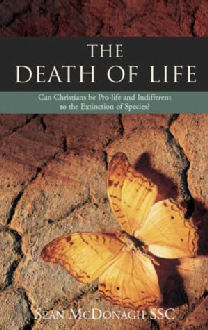
|
Posted July 20, 2005
Book: The Death of Life: The Horror of Extinction Author: Sean McDonagh SSC The Columbia Press, Dublin, Ireland, pp.152 An Excerpt from the Jacket:
The author considers the many habitats under threat of destruction, such as coral reefs and mangrove forests, as well as the different types of species threatened. He then looks at the position of the church on these issues and especially the work of Fr. Thomas Berry. He follows the historical relationship between church and nature from the Fathers of the Church to the present time. The final section is one of hope, looking at how different organizations and cultures might proceed in order to preserve biodiversity and save the many habits and species currently under threat. An Excerpt from the book: Human Vocation Within the perspective of the new cosmology, our unique human vocation is to celebrate the beauty and fruitfulness of all life on Earth. All life has a common ancestor. All species today share basic molecular traits. Tissue is divided into cells. The genetic information is stored in DNA; it is transcribed into RNA, and then translated into proteins. Finally, a large array of most similar proteins catalyst, the enzymes, accelerate all life processes. In the human species the earth and all the cosmos has become aware of itself in the thoughts, feeling, and imagination of individual human beings. This means that we must quickly grow out of the destructive adolescent phase of our development, which now threatens to destroy or degrade everything from our precious air to the creatures who live with us on the Earth and in the sea, and begin to actively care for Godís creation. Both as human beings and as Christians we are challenged to come to know, in a much more intimate way, the natural world around us. This is, after all, Godís creation. Only if we know it will we be able to celebrate and promote this love of life in the face of the culture of violence an death which is so prevalent in our times. Protecting life ought surely to be the vocation of every Christian today. Each generation of humans has its own particular task to accomplish. In the early part of the 19th century, it involved working to abolish slavery. Later in the 19th century, the focus moved to protecting workersí rights. These were momentous changes in human history but they could have come at a different point in time. The challenge facing this generation is quite different. It is one that has never faced a generation of humans in the past and never will be faced by a future generation of humans. This is the mass extinction of other creatures in just a few short decades. The task quite simply is to take decisive action to stave off the extinction of species which could sterilize the planet. If this generation does not act, no future generation will be able to undo the damage that this generation has caused to the planet. It is an extraordinary and awesome moment that the behavior of a single generation of humans can have such a profound and irreversible impact, not just on human history, but on the life of the planet as well. Sooner or later, extinction will rob our planet of the ability to sustain many forms of life, possibly even our own. Life on planet earth has developed and diversified during the past 3.8 billion years. Living forms moved into almost every nook and cranny on the planet. Humans had nothing to do with this florescence and we are one of the most recent arrivals at the table of life. Now the evolutionary future of the planet is quite simply in the hands of this generation. Table of Contents: 1. Introduction 2. Conversion in the Tíboli Hills 3. An adequate creation theology 4. Theology of forgot creation 5. Theological reflections 6. The need for an appropriate ethical framework 7. Called to live lightly on the earth |
|
